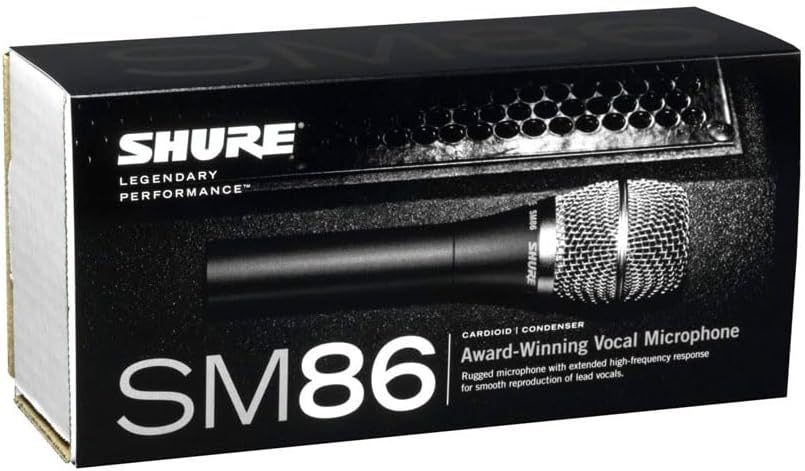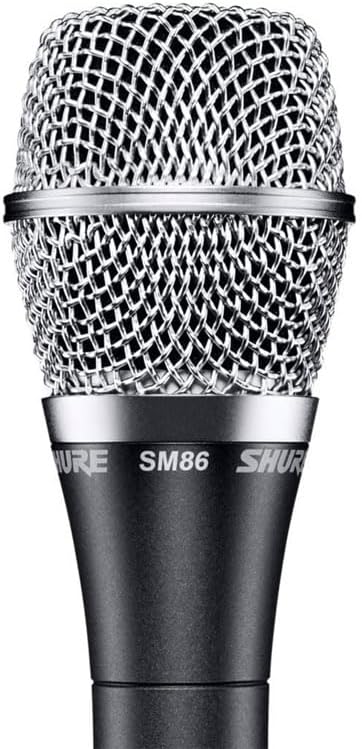Shure SM86 Review
When it comes to microphones, Shure is a name that resonates with reliability, quality, and performance. For decades, the company has been a staple in the audio industry, delivering tools that cater to everyone from bedroom producers to touring professionals. Among its impressive lineup, the Shure SM86 stands out as a lesser-known but highly capable vocal condenser microphone. Often overshadowed by its siblings like the SM58 and SM7B, the SM86 offers a unique blend of condenser clarity and dynamic durability, making it a compelling choice for live performers and studio enthusiasts alike. In this review, we’ll explore the Shure SM86’s design, sound quality, build, practical applications, and value proposition to determine where it shines and who it’s best suited for.
Shure SM86 Review

The Shure SM86 is a cardioid condenser microphone designed primarily for vocal applications. Introduced as part of Shure’s SM (Studio Microphone) series, it bridges the gap between the ruggedness of dynamic mics and the nuanced detail of condensers. Unlike the SM58, which is a dynamic microphone, the SM86 requires phantom power (typically 48V) to operate, aligning it more closely with studio-grade condensers while retaining a form factor suited for the stage.
With a frequency response of 50 Hz to 18 kHz and a tailored presence peak, the SM86 is engineered to capture the human voice with clarity and warmth. It boasts a maximum SPL (sound pressure level) of 147 dB, meaning it can handle loud vocalists without distortion, and its cardioid polar pattern ensures excellent off-axis rejection for live settings. At around $189 (as of March 2025), it sits in a mid-tier price range, making it accessible yet premium enough to warrant scrutiny. So, how does it perform in real-world scenarios? Let’s break it down.
Design and Build Quality
Straight out of the box, the Shure SM86 exudes the brand’s signature durability. Weighing in at 284 grams (10 ounces), it’s slightly heavier than the SM58, but it feels balanced and comfortable in hand. The microphone sports a sleek, all-metal construction with a matte black finish that’s both understated and professional. Its grille, made of hardened steel, is designed to withstand the rigors of live performance—think accidental drops or the occasional overzealous mic swing.
The SM86 includes a built-in three-stage pop filter, consisting of a foam layer and two metal mesh screens, which does an admirable job of minimizing plosives (those pesky “p” and “b” sounds). While it’s not entirely immune to wind noise in outdoor settings, it performs better than many handheld condensers in this regard. The mic also features an internal shock-mount system that reduces handling noise, a critical detail for performers who move around on stage.
One minor critique of the design is its lack of a standout aesthetic. It’s functional and no-nonsense, which is great for professionals, but it doesn’t have the iconic visual flair of, say, the SM58’s spherical grille. That said, the SM86 comes with a sturdy zippered pouch and a microphone clip, adding practical value to the package. Overall, the build quality is top-notch, living up to Shure’s reputation for creating gear that lasts.
Sound Quality: Clarity Meets Versatility
The heart of any microphone lies in its sound, and the SM86 delivers a performance that’s both refined and adaptable. As a condenser, it captures more detail and nuance than a dynamic mic like the SM58, offering a crisp, articulate sound that flatters a wide range of vocal tones. Its frequency response—50 Hz to 18 kHz—provides a solid low-end foundation without excessive muddiness, a smooth midrange, and a gentle boost in the upper mids (around 3-5 kHz) that enhances vocal presence.
In practice, the SM86 excels at bringing out the natural character of a voice. During testing with a mid-range male vocalist, the mic highlighted subtle inflections and breathy details without sounding harsh. Female vocalists with higher registers also benefited from its clarity, though those with particularly shrill tones might find the presence peak a touch too pronounced—nothing a slight EQ tweak can’t fix. Compared to the SM58, the SM86 offers a brighter, more open sound, making it ideal for singers who want their voice to cut through a dense mix.
The cardioid polar pattern is a standout feature, providing excellent rejection of background noise. In a live setting with monitors blaring and a crowd roaring, the SM86 maintained focus on the vocalist, minimizing bleed from drums or guitars. Its high SPL handling (147 dB) also means it can take a beating from belters or screamers without clipping, a rare trait for a condenser mic in this price range.
However, the SM86 isn’t perfect. Its condenser nature makes it more sensitive to ambient noise than a dynamic mic, so it’s less forgiving in untreated rooms or windy outdoor gigs. Additionally, the low-end response, while adequate, doesn’t have the thick, authoritative punch of a studio condenser like the AKG C414. This isn’t a flaw per se—it’s a design choice optimized for live vocals—but it’s worth noting for studio purists.
Performance in Live Settings
The SM86 was clearly built with live performance in mind, and it shines in this arena. During a test at a small venue with a four-piece band, the mic held its own against a noisy stage environment. The cardioid pattern kept feedback at bay, even with monitors positioned close to the singer, and the internal shock-mount minimized handling noise from an animated frontman. The pop filter also proved effective, taming plosives during aggressive rap verses and spirited choruses.
One of the SM86’s biggest strengths is its ability to deliver studio-quality sound on stage. Singers accustomed to dynamic mics might notice an immediate upgrade in detail, especially for genres like pop, jazz, or acoustic folk, where vocal texture is paramount. However, for hard rock or metal vocalists who rely on grit and proximity effect, the SM86’s cleaner profile might feel less visceral than an SM58 or Beta 58A.
Phantom power is a consideration here. Since the SM86 requires 48V, you’ll need a mixer or audio interface that can supply it. Most professional live setups already have this covered, but smaller venues or DIY gigs might require extra gear, adding a layer of complexity compared to plug-and-play dynamic mics.
Studio Applications: A Hidden Gem?
While marketed as a live vocal mic, the SM86 has untapped potential in the studio. In a controlled environment, its condenser capsule captures vocals with a level of detail that rivals pricier mics. During a recording session with an acoustic guitarist doubling as a vocalist, the SM86 produced a clean, natural take that required minimal post-processing. The slight presence boost added just enough sparkle to sit well in a mix, while the low-end remained tight and unobtrusive.
It’s not a replacement for a large-diaphragm condenser like the Neumann U87—lacking the same depth and airiness—but for home studios or mobile recording setups, it’s a versatile tool. It also doubles as a decent instrument mic for acoustic guitars or percussion, though its cardioid pattern limits its use for stereo techniques. The key takeaway? The SM86 is a jack-of-all-trades that punches above its weight in the studio, especially for budget-conscious creators.
Comparisons to the Competition
To fully appreciate the SM86, it’s worth comparing it to its peers. The Shure SM58 ($99) is the obvious benchmark—rugged, affordable, and ubiquitous. The SM86 outshines it in clarity and sensitivity, but it’s less forgiving and requires phantom power, making the SM58 the better pick for no-frills gigs. The Shure Beta 87A ($259), another condenser, offers a smoother high-end and tighter supercardioid pattern, but it’s pricier and more feedback-prone in chaotic live setups.
Outside the Shure family, the Sennheiser e865 ($249) is a direct competitor. Both mics deliver crisp condenser sound, but the e865 has a slightly wider frequency range (40 Hz–20 kHz) and a more neutral response, while the SM86’s tailored curve gives it a distinctive vocal lift. For sheer durability and value, the SM86 holds its own, striking a balance that’s hard to beat.
Pros and Cons
Pros:
- Exceptional vocal clarity for a handheld condenser
- Rugged build quality suited for live use
- Effective pop filter and shock-mount
- High SPL handling for loud sources
- Versatile for both stage and studio
Cons:
- Requires phantom power, limiting plug-and-play simplicity
- Presence peak can be too bright for some voices
- Not as warm or full-bodied as large-diaphragm condensers
- Sensitive to ambient noise in untreated spaces
Who Should Buy the Shure SM86?
The Shure SM86 is a niche but powerful tool. It’s ideal for:
- Live vocalists seeking condenser quality without sacrificing durability.
- Semi-pro musicians who perform and record on a budget.
- Venues or sound engineers upgrading from dynamic mics for clearer sound.
It’s less suited for beginners who need simplicity or studio purists chasing the ultimate vocal tone. If you’re comfortable with phantom power and value articulate sound in a tough package, the SM86 is a winner.
Final Thoughts
The Shure SM86 is a sleeper hit in Shure’s catalog—a microphone that combines the best of both worlds: the detail of a condenser and the resilience of a stage mic. At $189, it’s not the cheapest option, but its performance justifies the investment for the right user. Whether you’re commanding a live crowd or laying down tracks in a home studio, the SM86 delivers clarity, reliability, and versatility that few competitors can match. It may not have the fame of the SM58 or the polish of a high-end condenser, but it carves out its own space as a dependable workhorse with a touch of finesse. For vocalists ready to elevate their game, the Shure SM86 is well worth a listen.



